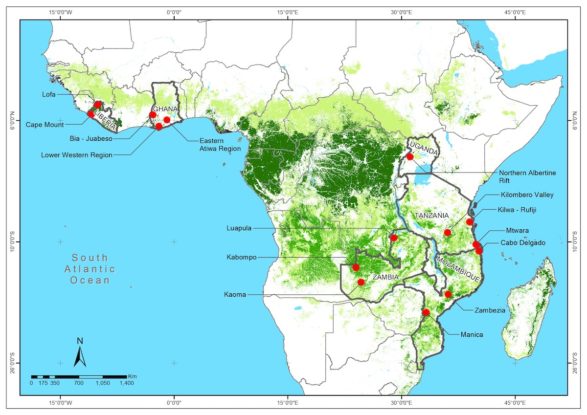Agriculture continues to present the biggest threat to forests worldwide. Some experts predict that crop production needs to be doubled by 2050 to feed the world at the current pace of population growth and dietary changes toward higher meat and dairy consumption. Scientists generally agree that productivity increase alone is not going to do the trick. Cropland expansion will be needed, most likely at the expense of large swathes of tropical forests – as much as 200million hectares by some estimates.
Nowhere is this competition for land between forests and agriculture more acute than in Africa. Its deforestation rate has surpassed those of Latin America and Southeast Asia. Sadly, the pace shows no sign of slowing down. Africa’s agriculture sector needs to feed its burgeoning populations- the fastest growing in the world. Africa will also continue to attract agricultural investments as investors turn away from rising pressures against forest conversion elsewhere in the world. What’s more, for the millions of unemployed African youth, a vibrant agriculture sector will deliver jobs and spur structural transformation of the rural economy. Taken together, the pressures on forests are immense. Unless interventions are made urgently, a large portion of Africa’s forests will be lost in the coming decades – one farm plot at a time.
The difficult question is: what interventions can protect forests and support farmers at the same time?
In Africa, smallholder farmers remain the primary agents of deforestation. Shifting cultivation and expansion of farmlands for commodity production by smallholders continue unabated. Although recent research shows that agricultural intensification– in which production is maximized on existing farms through the use of technology– has finally caught on in parts of the continent.
Still, there remains various hurdles to smallholder intensification in Africa: for starters, the farmers have limited access to markets and infrastructure. What’s more, financial and tenure insecurity of their land discourages technological adoption, because well, who wants to invest in something they have no security of owning? All the while farmers work with degraded soil unresponsive to fertilizer application. These are just a few obstacles presented. Addressing these root causes of smallholder-driven deforestation would require an integrated approach to forest conservation – one that improves smallholder productivity and livelihoods while curbing expansion to forests.
Governing multifunctional landscapes: a new project
To tackle these complex challenges, the Center for International Forestry Research (CIFOR) has launched a new initiative: The “Governing Multifunctional Landscapes (GML) in Sub-Saharan Africa: Managing Trade-Offs Between Social and Ecological Impacts”. The project will pilot an integrated territorial approach bespoke to the needs of the region – yet to be selected – until 2021.
In preparation, CIFOR scientists visited six African countries to conduct rapid assessments on the drivers of smallholder-linked deforestation, and to evaluate suitability of the landscapes for the project. The target countries were: Ghana, Liberia, Uganda, Tanzania, Zambia and Mozambique.

The 15 landscapes were chosen based on remote-sensing ganalysis. The target countries were: Ghana, Liberia, Uganda, Tanzania, Zambia and Mozambique
Here are our three reflections from the assessments, which we hope will enrich understanding and inspire exchanges on how to set the path forward for integrated territorial approaches in Africa.
Reflection #1: Complex drivers behind farmer expansion
A variety of reasons motivate smallholder farmers to convert forests to farms across the 15 landscapes.
The most common reason– seen across Zambia, Liberia, Mozambique, Tanzania and Uganda– is to practice shifting cultivation of staple crops such as maize, rice and cassava, and cash crops such as sesame, to take advantage of the nutrient-rich soil immediately after forest clearance. This practice also helps manage disease and weeds. We also found intimate linkages between shifting cultivation and charcoal production in some places where smallholders sought to maximize earnings from the newly-opened land, by selling freshly-felled tress to charcoal producers.
In landscapes with dynamic cash crop markets, we found patterns similar to those documented in Southeast Asia and Latin America: farmers clear forests to establish semi-permanent plots for cash crops such as cocoa (Ghana) and sugarcane (Uganda), attracted by prices and availability of a stable market.
Of course, broader macro-economic factors also motivate smallholder expansion. A declining fish stock has forced locals to switch to farming in Zambia, leading to expansion into the Miombo Woodlands. Migration internally and across the borders also contributes to smallholder-driven deforestation, as agro-pastoralists, refugees and economic migrants establish new farms in Tanzania, Zambia and Uganda.
These are just broad brushstrokes of the expansion patterns identified by our rapid assessments. While more rigorous studies are needed to understand them in depth, this cursory overview already demonstrates the diversity and complexity of the underlying factors driving smallholder expansion.
Reflection #2: Diverse crop types, multiple leverage points
Migration, charcoal production, shifting cultivation, cash crop expansion and many more factors weave a complex web of what drives smallholders to cut down forests. Such complexity calls for an integrated approach to leverage multiple entry points for intervention: market, government and of course, incentives to change the behaviours of smallholders themselves.
The integrated approach is particularly important since the rapid assessments show a varying level of usefulness for traditional market-focused supply chain initiatives due to the diversity in crop types and value chain configurations across landscapes. A few commodities driving deforestation, such as cocoa in Ghana, have the classic case for market-driven intervention thanks to sustainable sourcing commitments made by multinational companies. Other commodities, however, are trickier. For example, sesame production drives deforestation in parts of Tanzania and Mozambique. Destined for the Asian markets with weak consumer awareness, Asian buyers face little pressure to demand sustainability from smallholder sesame producers on the ground.